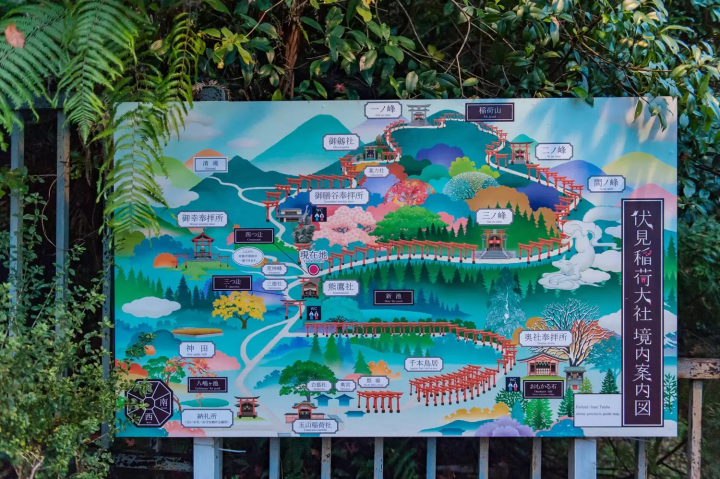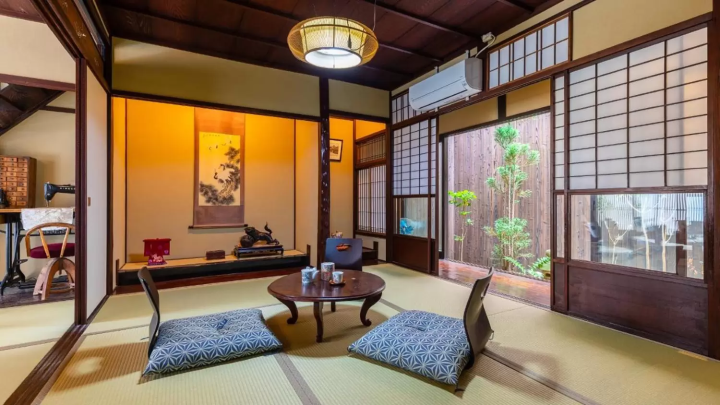Fushimi Inari Shrine: Highlights, Access From Kyoto Station, Hiking, and More

Fushimi Inari Taisha Shrine, famous for the Senbon Torii (thousand torii gates) lining its pathway, is a famous location accessible ten minutes by train from Kyoto Station. This article features the shrine's highlights, access, the time required to hike Mt. Inari, and recommended visiting times.
Fushimi Inari Taisha: Kyoto's Iconic Shrine
When you hear the phrase "There are 30,000 of them across Japan", what do you think this number refers to? The number of convenience stores in the country? The number of vending machines installed nationwide?
No, it's actually the number of Inari Shrines located across Japan!
An Inari shrine is dedicated to Inari, the Japanese guardian deity of bountiful harvests, prosperous businesses, safe childbirth, and recovery from illness. Shrine visitors even offer prayers for success in academic exams.

Photo by Pixta
Inari shrines can be found all around Japan, but Fushimi Inari Taisha, or the Fushimi Inari Grand Shrine in Kyoto is the head shrine of all Inari shrines in Japan.
Read on to learn more about the highlights of Fushimi Inari Taisha Shrine. We introduce information on the famous Senbon Torii ("Thousand Torii Gates"), the time required to hike Mt. Inari, and access from Kyoto Station.
Table of Contents
1. Fushimi Inari Taisha: Kyoto's Iconic Shrine
2. The History of Fushimi Inari Taisha
3. The Ten Thousand Torii Shrine Gates
4. Fushimi Inari Taisha and Foxes
5. Hiking Mt. Inari
6. Photography and Precautions
7. Business Hours and Recommended Visiting Hours
8. Required Time and Entrance Fees
9. Nearby Kyoto Hotels
10. Accessto Fushimi Inari Shrine
11. Closing Words
Travel Japan on a deal! Purchase the convenient JAPAN RAIL PASS
Fushimi Inari Taisha: 1,300 Years of History
Fushimi Inari Shrine was constructed on Mt. Inari approximately 1,300 years ago.

Photo by Pixta
Although not a registered World Heritage site, the main hall is a nationally designated important cultural property.
The number of visitors hoping to receive blessings and visit the shrine on hatsumode (the first shrine visit of the New Year) exceeds 2.5 million people annually! That's because this prestigious shrine is loved and worshiped by locals in the Kansai region and people nationwide.
Senbon Torii: The Ten Thousand Torii Shrine Gates
Continue past the main hall to find the Senbon Torii. These rows of vermilion torii gates line the pathway and are a major highlight at Fushimi Inari Shrine.
The spectacle features 10,000 torii gates tightly lining the path along the Mt. Inari mountain trail, where the main hall is located. This is a truly magnificent sight!

These torii gates aren't solely decorative. Pay close attention and you'll see people's names engraved on the back of each torii gate. These names reflect individuals or companies that performed the act of dedicating a torii gate to the shrine.

Those who visited Fushimi Inari Shrine and had their wishes granted observe a certain custom. This involves dedicating a torii gate to the shrine to express gratitude.
This beautiful, majestic sight was constructed at the shrine after thousands returned and dedicated a torii gate in their name.

Photo by Pixta
The Thousand Lantern Festival (Japanese), an event where the Senbon Torii gates are illuminated with the light from lanterns, was held for the first time during a 10-day period starting on October 1, 2022.
Although the 2023 date has yet to be confirmed (as of April 2023), the sight of the Senbon Torii enveloped in a fantastical atmosphere is something you'd want to see at least once. Please check the official website for the latest information.
Fushimi Inari Shrine and Foxes
Byakko, a term referring to white foxes in Fushimi Inari Shrine, are sacred animals that serve as messengers of the deity.
Several stone byakko statues are placed throughout the grounds to protect and watch over the shrine.

Photo by Pixta
If you look closely at any byakko statue, you'll notice that each figure is holding something different in its mouth. This includes an ear of rice, a scroll, a jewel, or keys.
These items respectively symbolize different wishes. An ear of rice is derived from the fact that Inari is the god of agriculture, a scroll for wisdom, a jewel for benevolence, and keys for acquiring benevolent virtue.
Hiking Mt. Inari! How Many Hours to the Summit?

Photo by Pixta
Fushimi Inari Shrine sits at the base of Mt. Inari, which rises 233 meters above the shrine grounds.
You can sightsee within the main hall, a nationally designated Important Cultural Property, and a portion of the Senbon Torii without hiking up the mountain. Nonetheless, why not enjoy hiking if you want to see the exhilarating landscape from the summit?

Photo by Pixta
The time required to hike to the summit is about an hour one-way, while a round trip would be two hours. Peak hours are an exception.
The mountain trail may not be steep, but wearing shoes that are easy to walk in, like sneakers, is recommended. Vending machines selling drinks are also located along the trail, but we recommend purchasing drinks beforehand since the prices are fairly steep.
Photography and Precautions

Photo by Pixta
There are many photogenic spots at Fushimi Inari Shrine. The Senbon Torii, shrouded in its mystical atmosphere, is one example.
However, please remember when taking pictures that this is a sacred site for visitors offering prayers to deities.
The following actions are prohibited at Fushimi Inari Shrine: drone photography, photos in prohibited zones, visiting the shrine in a wedding dress or inappropriate clothing, and photography on narrow roads. Avoid the actions above, and make sure to take photos while paying attention to your surroundings not to be a hindrance to others! Please check the official website for details.

Photo by Pixta
Kimono Rentals
Looking for a more authentic Japanese experience? Then we recommend visiting the shrine in a kimono. Kimono rentals are a popular activity, but it is possible to book your rental in advance with the travel and activity booking website klook!
Fushimi Inari Shrine has areas with continuous stairs, so it may be difficult for you to move in a kimono. Please keep this in mind.
Click Here to Book Your Kimono Rentals on klook!
On-Location Photography Services
A photoshoot taken by a professional photographer is a popular option for making memories in Kyoto.
There are many on-location photography services out there. Go with Capture My Japan, which has many foreign-language-speaking photographers registered under their service. You can get wonderful photos taken without needing to speak Japanese!
Business Hours and Recommended Visiting Hours

Photo by Pixta
Business Hours
Fushimi Inari Shrine can be visited at any time, any day, as it is open 24 hours a day, 365 days a year.
However, prayer ceremonies are held between 8:30 - 16:00. A prayer ceremony is a request made to the Shinto priest to relay your wishes to the deities.
Recommended Visiting Hours
Fushimi Inari Shrine is one of Kyoto's most prominent and popular spots. As such, it tends to get crowded between 8:00 in the morning and 17:00 in the evening.
If you want to visit while avoiding crowds, we recommend visiting early in the morning or at night. The shrine grounds will have enhanced sanctity from the refreshing morning air. Similarly, you can experience a mystical atmosphere illuminated by lights at night!
Required Time and Entrance Fees

Photo by Pixta
Required Time
The shortest time needed at Fushimi Inari Shrine is 30 minutes. The most typical sightseeing route is starting from the main hall at the entrance, walking through the Senbon Torii, and heading to Okusha Hohaisho on the other side of the gates before returning to the start.
If you plan to hike to the summit of Mt. Inari while stopping to take breaks, you should estimate about three hours for the entire route.
Entrance Fees
Entry into the shrine is free.
We recommend writing on an ema (*1) for a memorable experience. The ema at Fushimi Inari Shrine is fox-shaped due to its association with the shrine, costing around 500 yen. You can write or draw whatever you want on the fox's face, making unforgettable memories while jotting down your wishes and dedicating an ema to the deities!
*1 Ema: a plaque used to write your wishes, then dedicated to a temple or shrine.
Stay at a Nearby Hotel and Visit Early Morning or Night!
Want to visit the shrine and take photos while avoiding crowds? We recommend staying at a nearby hotel. This makes it easier to visit Fushimi Inari Shrine in the early morning or at night.

Picture courtesy of Booking.com
Inari Ohan, a remodeled Japanese home full of charm, is an accommodation nine minutes on foot from Fushimi Inari Shrine. The rooms in this two-storied building come with a simple kitchen, making it possible for guests to enjoy a stay in Kyoto as if living in a Japanese home.
Some of the reviews from overseas guests include "The kitchen is a little on the smaller side," and "I'm satisfied that I was able to stay comfortably in a quiet and private space."
Click Here to Book Inari Ohan on Booking.com!

Picture courtesy of agoda
Do you want to stay near Fushimi Inari Shrine at a reasonable price? Then we recommend SO Kyoto Fushimi Inari.
The hotel is only five minutes on foot to Fushimi Inari Shrine. The fact that there are washing machines in these modern yet simple guest rooms is another excellent feature.
The reviews from overseas guests include "There was no elevator," and "I felt like it was more than worth the price."
Click Here to Book a Room at SO Kyoto Fushimi Inari on Booking.com!
Click Here to Book a Room at SO Kyoto Fushimi Inari on agoda!
Access from Kyoto Station

Photo by Pixta
You can access Fushimi Inari Shrine from JR Kyoto Station in ten minutes by train and walking.
First, take a train along the JR Nara Line from JR Kyoto Station and alight at Inari Station. You will arrive at the shrine in five minutes on foot from the station.
Moreover, the JR Nara Line is a route covered by the JAPAN RAIL PASS—an unlimited ride pass that helps overseas visitors save money while traveling within Japan. For this reason, we recommend purchasing this pass to travel to Fushimi Inari Shrine without additional expenses.
For details on the JAPAN RAIL PASS, be sure to check out this MATCHA article!
Closing Words
We introduced highlights of Fushimi Inari Shrine and how to enjoy yourself, starting with the Senbon Torii.
The shrine is accessible in ten minutes by train from Kyoto Station, so be sure to visit on your next trip to Kyoto!
Hotels near Fushimi Inari Taisha Shrine
Read also
Main image by Pixta
*This article is an updated 2023 version of an article published in June 2014.
This is the official account of MATCHA's editorial department. Our articles feature useful travel information for visitors to Japan, from how-to guides to recommended places to visit.













































![[Gunma] 5 recommended gourmet foods at Kawaba Denen Plaza Roadside Station!](https://resources.matcha-jp.com/resize/720x2000/2025/02/26-225970.webp)
![[Kanazawa] Enjoy the world of gold leaf to the fullest in the city with the highest production volume in Japan](https://resources.matcha-jp.com/resize/720x2000/2025/11/12-249564.webp)
![[2026] Family Winter Trip to Suzuka Circuit! – For Both Day trips and Overnight Stays!](https://resources.matcha-jp.com/resize/720x2000/2025/12/26-254097.webp)

![[2026] Top 5 Strawberry Picking Spots in Tokushima, Naruto| Farms and Access Guide for January to May](https://resources.matcha-jp.com/resize/720x2000/2025/03/06-227165.webp)